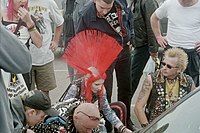
Photo from wikipedia
Abstract The architecture and mechanics of an orogen can be understood in terms of a system of collages that are characterized by a complex assemblage of multiple components, but the… Click to show full abstract
Abstract The architecture and mechanics of an orogen can be understood in terms of a system of collages that are characterized by a complex assemblage of multiple components, but the fundamental paleogeographic framework and the tectonic relationships between the different components are often insufficiently defined, because of unavailable data. The Central Asian Orogenic Belt (CAOB) provides an ideal opportunity to address the fundamental framework of paleogeography and tectonic relationships between the diverse and many components in this huge collage. In this paper we review several lines of available evidence, which enable us to propose a new tectonic model of huge roll-back in the formation of the accretionary tectonics of the Mongolian collage in Central Asia. In the early Paleozoic the Mongolia collage comprised the southern Siberian and the Tuva-Mongol Oroclines. The Siberia Craton and the Mongolia collage jointly formed a giant “tadpole-shape” within the Paleo-Asian and Panthanlassic oceans; its head (Siberia) was to the south, and the tail (Tuva-Mongol) to the northwest. The structures and tectonic zonation of the Mongolia collage are characteristic of multiple arcs, which have been separately described in detail in different segments southwards from the Southern Siberia-East Sayan, West Sayan-Gorny Altai-Chara, via the Lake Zone-Junggar-Tianshan, Gobi Altai-Beishan-Alxa, to the Manlay-Hegenshan-Baolidao-Solonker segments. Almost all segments underwent Early Paleozoic to Permian, or even Triassic, frontal subduction and accretion, while rifting in the Late Carboniferous to Permian or Triassic occurred in the outward/oceanward (westward) advancing Mongolian collage. Therefore, we suggest that a huge complex roll-back, active from the Carboniferous to Permian or even to late Triassic, facilitated the formation of the Mongolian collage. The outward multiple roll-back process was compatible and almost coeval with the start of the Tuva-Mongol Orocline and rotation of the Siberian Craton, as confirmed by paleomagnetic and structural data. During the roll-back processes an archipelago paleogeography was formed behind the frontal subduction and accretion, in which independent arcs or terranes were amalgamated or collided to form composite arcs or terranes either simultaneously or at slightly different times. The roll-back process was affected by the collision of the Kazakhstan collage along the Chara and Karamay zones in the Early Permian, the collision of the Tarim Craton along the South Tianshan zone in the Early Permian, the collision of the Dunhuang Block along the Liuyuan zone in the Early Permian-Triassic, the collision of the Alxa block along the Qugan Qulu zone in the Permian, and the collision of the North China Craton along the Solonker zone in the Middle-Late Triassic. The tectonic styles and architecture of accretionary orogenic belts like the CAOB are characterized both by the amalgamation of multiple terranes and by oroclinal bending. The systematic anatomy of the multiple roll-back processes and their interactions with the adjacent collages shed light on the evolving orogenic architecture and the crustal accretionary history of orogens.
Journal Title: Earth-Science Reviews
Year Published: 2018
Link to full text (if available)
Share on Social Media: Sign Up to like & get
recommendations!